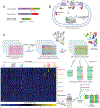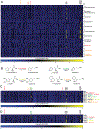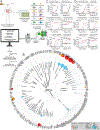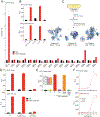Highly multiplexed bioactivity screening reveals human and microbiota metabolome-GPCRome interactions
- PMID: 37321219
- PMCID: PMC10330796
- DOI: 10.1016/j.cell.2023.05.024
Highly multiplexed bioactivity screening reveals human and microbiota metabolome-GPCRome interactions
Abstract
The human body contains thousands of metabolites derived from mammalian cells, the microbiota, food, and medical drugs. Many bioactive metabolites act through the engagement of G-protein-coupled receptors (GPCRs); however, technological limitations constrain current explorations of metabolite-GPCR interactions. Here, we developed a highly multiplexed screening technology called PRESTO-Salsa that enables simultaneous assessment of nearly all conventional GPCRs (>300 receptors) in a single well of a 96-well plate. Using PRESTO-Salsa, we screened 1,041 human-associated metabolites against the GPCRome and uncovered previously unreported endogenous, exogenous, and microbial GPCR agonists. Next, we leveraged PRESTO-Salsa to generate an atlas of microbiome-GPCR interactions across 435 human microbiome strains from multiple body sites, revealing conserved patterns of cross-tissue GPCR engagement and activation of CD97/ADGRE5 by the Porphyromonas gingivalis protease gingipain K. These studies thus establish a highly multiplexed bioactivity screening technology and expose a diverse landscape of human, diet, drug, and microbiota metabolome-GPCRome interactions.
Keywords: G protein-coupled receptor (GPCR); high-throughput screening; human metabolome; microbiome; microbiota metabolites.
Copyright © 2023 Elsevier Inc. All rights reserved.
Conflict of interest statement
Declaration of interests N.W.P is a co-founder of Artizan Biosciences and Design Pharmaceuticals. N.W.P has received research funding for unrelated studies from Artizan Biosciences and F. Hoffmann-La Roche AG. H.C., A.M.R., and N.W.P. are inventors on a patent application covering the PRESTO-Salsa system.
Figures







References
Publication types
MeSH terms
Substances
Grants and funding
LinkOut - more resources
Full Text Sources
Research Materials
Miscellaneous

